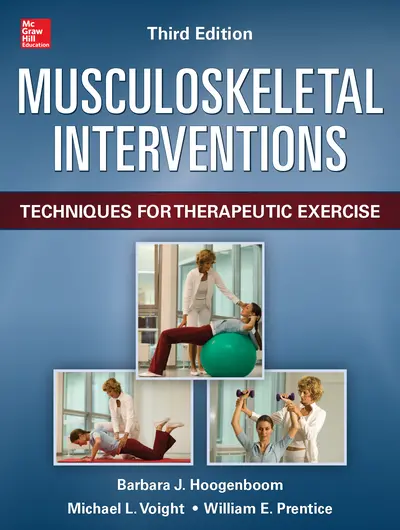My Account Details

ISBN10: 0071793704 | ISBN13: 9780071793704

Step 1 . Download Adobe Digital Editions to your PC or Mac desktop/laptop.
Step 2. Register and authorize your Adobe ID (optional). To access your eBook on multiple devices, first create an Adobe ID at account.adobe.com. Then, open Adobe Digital Editions, go to the Help menu, and select "Authorize Computer" to link your Adobe ID.
Step 3. Open Your eBook. Use Adobe Digital Editions to open the file. If the eBook doesn’t open, contact customer service for assistance.
The definitive guide to designing and implementing evidence-based rehabilitation programs using therapeutic exercise -- updated in full color Musculoskeletal Interventions, 3rd Edition, is a comprehensive guide to the system considerations, design, implementation, and progression of rehabilitation programs for musculoskeletal injuries and dysfunction. Encompassing many aspects of musculoskeletal rehabilitation, with contributions from many renowned authors, it focuses on the practical application of theory in a clinical setting, making it valuable to both students and experienced physical therapists. Musculoskeletal Interventions features an easy-to-follow body region and functional approach to intervention strategies and is logically divided into five sections: Foundations of the Rehabilitation Process Addresses the important considerations in designing a rehabilitation program for the patient with a musculoskeletal injury Provides a guide-based overview of the rehabilitation process as well as an introduction to Clinical Reasoning and Algorithmic Thinking in rehabilitation Treating Physiologic Impairments During Rehabilitation Presents information on various physical impairments that may need to be addressed as part of the rehabilitation process The Tools of Rehabilitation Provides an overview of important rehabilitation tools and strategies Delivers detailed coverage of how these interventions should be incorporated into a rehabilitation program to achieve the individualized treatment goals for patients with musculoskeletal pathologies Intervention Strategies for Specific Injuries Covers specific rehabilitation techniques and interventions applied to the treatment of a wide variety of regional musculoskeletal injuries, dysfunctions, and post-operative conditions Special Consideration for Specific Patient Populations Discusses treatment considerations for specific patient populations, such as the geriatric patient, pediatric patient, and physically active female This edition is enhanced by a new full-color presentation, as well as the inclusion of valuable learning aids, such as clinical pearls, protocol grids, algorithms, learning objectives at the beginning of each chapter, and end-of-chapter treatment guidelines and references.
Chapter 1: Introduction to theRehabilitation Process: The Guide toPhysical Therapist Practice
Chapter 2: Clinical Decision Making inRehabilitation, The Patient-ClientManagement Model
Chapter 3: Understanding and Managingthe Healing Process throughRehabilitation
Chapter 4: The NeuromuscularScanning Examination
Chapter 5: Clinical Reasoning: AnAlgorithm-based Approach toMusculoskeletal Rehabilitation
Part II: Treating PhysiologicImpairments DuringRehabilitation
Chapter 6: Impairment Due to Pain:Managing Pain During the RehabilitationProcess
Chapter 7: Impaired Posture andFunction
Chapter 8: Impaired MusclePerformance: Regaining MuscularStrength and Endurance
Appendix A: ACSM Position Statements onStrength Training
Chapter 9: Impaired Endurance:Maintaining Aerobic Capacity andEndurance
Appendix B: ACSM PositionStatements on Fitness Development
Chapter 10: Impaired Mobility: RestoringRange of Motion and ImprovingFlexibility
Chapter 11: Impaired NeuromuscularControl: Reactive NeuromuscularTraining
Part III: The Tools ofRehabilitation
Chapter 12: Isokinetics in Rehabilitation
Chapter 13: Plyometric Exercise in Rehabilitation
Chapter 14: Open- versusClosed-Kinetic Chain Exercises inRehabilitation
Chapter 15: ProprioceptiveNeuromuscular Facilitation Techniquesin Rehabilitation
Chapter 16: Joint MobilizationTechniques in Rehabilitation
Chapter 17: Strategies for ImprovingBalance
Chapter 18: Core Stabilization inRehabilitation
Chapter 19: Aquatic Therapy inRehabilitation
Chapter 20: Functional MovementScreening
Chapter 21: Functional Progressionsand Functional Testing in Rehabilitation
Chapter 22: Orthotics in Rehabilitation
Chapter 23: Designing Exercise Programs for Home and Clinical Progressions
Chapter 24: Essentials of FunctionalExercise: A Four-Step Clinical Model forTherapeutic Exercise Prescription
Part IV: Interventions Strategiesfor Specific Regions
Chapter 25: Rehab of the Shoulder
Chapter 26: Rehab of the Elbow
Chapter 27: Rehab of the Wrist, Handand Fingers
Chapter 28: Rehab of the Groin, Hip, andThigh
Chapter 29: Rehab of the Knee
Chapter 30: Rehab of the Lower Leg
Chapter 31: Rehab of the Ankle and Foot
Chapter 32: Rehab of Injuries to theSpine
Part V: Special Considerationsfor Specific Patient Populations
Chapter 33: RehabilitationConsiderations with the Geriatric Patient
Chapter 34: Considerations for thePediatric Patient
Chapter 35: Considerations for treatingAmputees
Chapter 36: Considerations for theActive Female
Need support? We're here to help - Get real-world support and resources every step of the way.